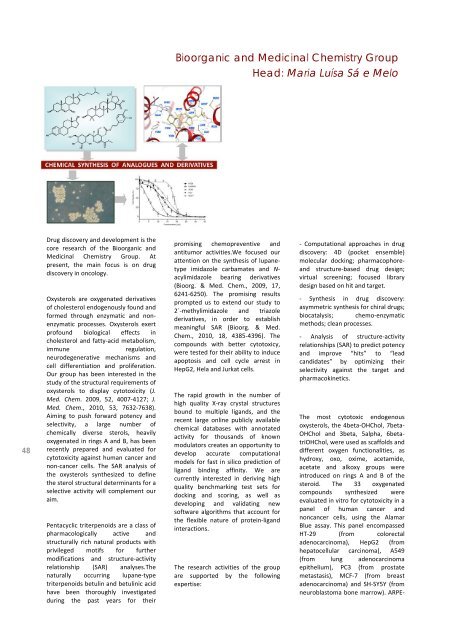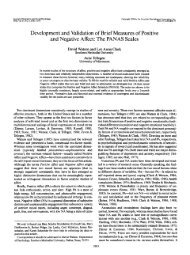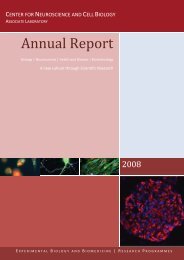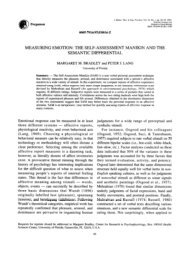Bioorganic <strong>and</strong> Medicinal Chemistry GroupHead: Maria Luísa Sá e Melo48Drug discovery <strong>and</strong> development is the core research <strong>of</strong> the Bioorganic <strong>and</strong> Medicinal Chemistry Group. At present, the main focus is on drug discovery in oncology. Oxysterols are oxygenated derivatives <strong>of</strong> cholesterol endogenously found <strong>and</strong> <strong>for</strong>med through enzymatic <strong>and</strong> non-enzymatic processes. Oxysterols exert pr<strong>of</strong>ound biological effects in cholesterol <strong>and</strong> fatty-‐acid metabolism, immune regulation, neurodegenerative mechanisms <strong>and</strong> cell differentiation <strong>and</strong> proliferation. Our group has been interested in the study <strong>of</strong> the structural requirements <strong>of</strong> oxysterols to display cytotoxicity (J. Med. Chem. 2009, 52, 4007-‐4127; J. Med. Chem., 2010, 53, 7632-‐7638). Aiming to push <strong>for</strong>ward potency <strong>and</strong> selectivity, a large number <strong>of</strong> chemically diverse sterols, heavily oxygenated in rings A <strong>and</strong> B, has been recently prepared <strong>and</strong> evaluated <strong>for</strong> cytotoxicity against human cancer <strong>and</strong> non-‐cancer cells. The SAR analysis <strong>of</strong> the oxysterols synthesized to define the sterol structural determinants <strong>for</strong> a selective activity will complement our aim. Pentacyclic triterpenoids are a class <strong>of</strong> pharmacologically active <strong>and</strong> structurally rich natural products with privileged motifs <strong>for</strong> further modifications <strong>and</strong> structure-‐activity relationship (SAR) analyses.The naturally occurring lupane-‐type triterpenoids betulin <strong>and</strong> betulinic acid have been thoroughly investigated during the past years <strong>for</strong> their promising chemopreventive <strong>and</strong> antitumor activities.We focused our attention on the synthesis <strong>of</strong> lupane-type imidazole carbamates <strong>and</strong> N-acylimidazole bearing derivatives (Bioorg. & Med. Chem., 2009, 17, 6241-‐6250). The promising results prompted us to extend our study to 2´-‐methylimidazole <strong>and</strong> triazole derivatives, in order to establish meaningful SAR (Bioorg. & Med. Chem., 2010, 18, 4385-‐4396). The compounds with better cytotoxicy, were tested <strong>for</strong> their ability to induce apoptosis <strong>and</strong> cell cycle arrest in HepG2, Hela <strong>and</strong> Jurkat cells. The rapid growth in the number <strong>of</strong> high quality X-‐ray crystal structures bound to multiple lig<strong>and</strong>s, <strong>and</strong> the recent large online publicly available chemical databases with annotated activity <strong>for</strong> thous<strong>and</strong>s <strong>of</strong> known modulators creates an opportunity to develop accurate computational models <strong>for</strong> fast in silico prediction <strong>of</strong> lig<strong>and</strong> binding affinity. We are currently interested in deriving high quality benchmarking test sets <strong>for</strong> docking <strong>and</strong> scoring, as well as developing <strong>and</strong> validating new s<strong>of</strong>tware algorithms that account <strong>for</strong> the flexible nature <strong>of</strong> protein-‐lig<strong>and</strong> interactions. The research activities <strong>of</strong> the group are supported by the following expertise: -‐ Computational approaches in drug discovery: 4D (pocket ensemble) molecular docking; pharmacophore-‐ <strong>and</strong> structure-‐based drug design; virtual screening; focused library design based on hit <strong>and</strong> target. -‐ Synthesis in drug discovery: asymmetric synthesis <strong>for</strong> chiral drugs; biocatalysis; chemo-‐enzymatic methods; clean processes. -‐ Analysis <strong>of</strong> structure-‐activity relationships (SAR) to predict potency <strong>and</strong> improve “hits” to “lead c<strong>and</strong>idates” by optimizing their selectivity against the target <strong>and</strong> pharmacokinetics. The most cytotoxic endogenous oxysterols, the 4beta-‐OHChol, 7beta-‐OHChol <strong>and</strong> 3beta, 5alpha, 6beta-triOHChol, were used as scaffolds <strong>and</strong> different oxygen functionalities, as hydroxy, oxo, oxime, acetamide, acetate <strong>and</strong> alkoxy groups were introduced on rings A <strong>and</strong> B <strong>of</strong> the steroid. The 33 oxygenated compounds synthesized were evaluated in vitro <strong>for</strong> cytotoxicity in a panel <strong>of</strong> human cancer <strong>and</strong> noncancer cells, using the Alamar Blue assay. This panel encompassed HT-‐29 (from colorectal adenocarcinoma), HepG2 (from hepatocellular carcinoma), A549 (from lung adenocarcinoma epithelium), PC3 (from prostate metastasis), MCF-‐7 (from breast adenocarcinoma) <strong>and</strong> SH-‐SY5Y (from neuroblastoma bone marrow). ARPE-‐
4919 (from retinal pigment epithelium) <strong>and</strong> BJ (from skin fibroblast cells) were used as models <strong>of</strong> human noncancer cells to gain insights on the preferential cytotoxicity against cancer cells. These studies revealed a broad antiproliferative activity <strong>for</strong> the oxysterols in a low micromolar range with increased activities on LAMA-‐84, HT-‐29, HepG2 <strong>and</strong> MCF-‐7 cells. From the selectivity indexes <strong>and</strong> SAR analysis, a set <strong>of</strong> compounds were identified with very high selectivity. The neuroblastoma cells showed resistance to the majority <strong>of</strong> the oxysterols, although some derivatives presented increased cytotoxicity. This work demonstrated how structural modifications in natural oxysterols have an impact on their selective cytotoxicity (J. Med. Chem. <strong>2011</strong>, 54, 6375-‐6393). The synthetic work, including ours, in the use <strong>of</strong> enzymes in biocatalytic trans<strong>for</strong>mations <strong>of</strong> steroids, under chemo-‐, regio-‐ <strong>and</strong> stereoselective control, has been compiled in a review article (Curr. Org. Chem., <strong>2011</strong>, 15(6), 928-‐941). Recently, we focused our attention on the synthesis <strong>of</strong> lupane-‐type imidazole carbamates, N-‐acylimidazole bearing derivatives <strong>and</strong> 2´-‐methylimidazole <strong>and</strong> triazole derivatives, in order to establish meaningful SAR <strong>and</strong> study their ability to induce apoptosis <strong>and</strong> cell cycle arrest in HepG2, Hela <strong>and</strong> Jurkat cells. The overall findings suggest that some <strong>of</strong> the new lupane-type derivatives are strong regulators <strong>of</strong> tumor cells proliferation, inducing cell cycle arrest <strong>and</strong> apoptosis through a caspase-‐based mechanism. (Biochimie, <strong>2011</strong>, 93, 1065-‐1075).The synthesis <strong>of</strong> new related triterpenoid compounds is currently underway (Adv. Synth. Catal., <strong>2011</strong>, 353, 2637-‐2642). Mechanics method <strong>for</strong> virtual lig<strong>and</strong> screening was tested against the 40 DUD target benchmarks <strong>and</strong> 11-‐target WOMBAT sets. The self-‐docking accuracy was evaluated <strong>for</strong> the top 1 <strong>and</strong> top 3 scoring poses at each lig<strong>and</strong> binding site with near native con<strong>for</strong>mations below 2 Å RMSD found in 91% <strong>and</strong> 95% <strong>of</strong> the predictions, respectively. The virtual lig<strong>and</strong> screening using single rigid pocket con<strong>for</strong>mations provided the median area under the ROC curves equal to 69.4 with 22.0% true positives recovered at 2% false positive rate. Significant improvements up to ROC AUC= 82.2 <strong>and</strong> ROC (2%) = 45.2 were achieved following our best practices <strong>for</strong> flexible pocket refinement. Our results confirm the usefulness <strong>of</strong> con<strong>for</strong>mation ensembles to improve protein-‐lig<strong>and</strong> recognition using the structure-‐based approach. The benchmarking results, current developments in the docking-‐based drug design <strong>and</strong> future prospects were presented during a symposium at the 241st ACS National Meeting held in March <strong>2011</strong> in Anaheim, CA, <strong>and</strong> were accepted <strong>for</strong> publication in the Journal <strong>of</strong> Computer-‐Aided Drug Design.To demonstrate the usefulness <strong>of</strong> virtual lig<strong>and</strong> screening in structure-based drug discovery, flexible docking <strong>and</strong> scoring was benchmarked <strong>for</strong> lig<strong>and</strong> binding mode prediction against high quality co-‐crystal structures available in the Protein Data Bank. The Internal Coordinate
- Page 1: Center for Neuroscience and Cell Bi
- Page 5: Introduction |General Objectives5CN
- Page 9 and 10: OrganizationThe Center for Neurosci
- Page 11 and 12: Neuroscience and Disease AreaCoordi
- Page 13: Mitochondrial Dysfunction and Si
- Page 16 and 17: Glutamatergic Synapses GroupHead: A
- Page 18 and 19: Neuroprotection and Neurogenesis in
- Page 20 and 21: Neuronal Cell Death and Neuroprotec
- Page 22 and 23: Mitochondrial Dysfunction and Signa
- Page 24 and 25: Molecular Mechanisms of Disease Gro
- Page 26 and 27: 26fluoxetine promotes the prolif
- Page 28 and 29: 28Project 3: B cells against C
- Page 30 and 31: Finley, L.W., Carracedo, A., Le
- Page 32 and 33: Santos, S.D., Iuliano, O., Ribe
- Page 34 and 35: Molecular Biotechnology Group Vec
- Page 37 and 38: Molecular Biotechnology GroupHead:
- Page 39 and 40: Molecular Systems Biology GroupHead
- Page 41 and 42: Structural and Computational Biolog
- Page 43 and 44: Vectors and Gene Therapy GroupHead:
- Page 45 and 46: Biomaterials and Stem Cell-Based Th
- Page 47: Pharmacometrics GroupHead: Amílcar
- Page 51 and 52: Khadem, M., Camacho, R., Nóbre
- Page 53: IN PRESS Correia, S., Vinhas, R
- Page 56 and 57: Mitochondrial Toxicology and Dis
- Page 58 and 59: Redox Biology in Health and Disease
- Page 60 and 61: (2011) Changes in glucose uptak
- Page 62 and 63: 6223. Duarte, F.V., Teodoro, J.S
- Page 64 and 65: Microbiology of Extreme Environm
- Page 66 and 67: Medical Mycology - Yeast Research G
- Page 68 and 69: IN PRESS Anjos, J., Fernandes,
- Page 70 and 71: Inorganic Biochemistry and Molec
- Page 72 and 73: 72Main Achievements A) New Gd(II
- Page 74 and 75: appearance. Insulin and c-‐p
- Page 76 and 77: IN PRESS Barosa, C., Silva, C.,
- Page 78 and 79: 78Cellular Immunology and Oncobi
- Page 80 and 81: inhibiting TNF-‐α and CCL5
- Page 82 and 83: Infection, Phagocytosis and Pathoge
- Page 84 and 85: 84metabolism as well as on gen
- Page 86 and 87: Ramalho-‐Santos, J. (2011) H
- Page 88 and 89: 1. Psychiatry Research Carlos Pa
- Page 90 and 91: Fanous, A.H., Middleton, F., Ge
- Page 92 and 93: PUBLICATIONS Santos, M.J., Marque
- Page 94 and 95: Andrade, P., Gonçalo, M. (2011
- Page 96 and 97: PUBLICATIONS Costa, A.L., Silva,
- Page 99 and 100:
InternationalizationInternationaliz
- Page 101 and 102:
Role of difusible and contact
- Page 103 and 104:
Retroviral-‐like membrane-
- Page 105 and 106:
Harvard Medical School), Mª Ot
- Page 107 and 108:
5 th Annual Meeting on Cell Sig
- Page 109 and 110:
Graduate Studies ProgrammeThe Cent
- Page 111 and 112:
Excitotoxic Signaling October 19
- Page 113 and 114:
FEBRUARY 3.2.2011 Peripheral nervo
- Page 115 and 116:
11.11.2011 Keeping mitochondria i
- Page 117 and 118:
Ana Raquel Santos Calhôa Mano
- Page 119 and 120:
Paula Cristina Cardoso Ramos Mo
- Page 121 and 122:
Master thesis Ana Isabel Reis S
- Page 123 and 124:
Marta Maria Vieira Matutino Fal
- Page 125 and 126:
Outreach ProgrammeThe Outreach Pr
- Page 127 and 128:
Technology TransferTranslational r
- Page 129 and 130:
Core FacilitiesCNC research Core
- Page 131 and 132:
FLOW CYTOMETRY UNITHead of Unit: Is
- Page 133 and 134:
MASS SPECTROSCOPY UNITHead of Unit:
- Page 135 and 136:
ServicesCNC Laboratório Associad
- Page 137 and 138:
137Mitochondrial DNA (mtDNA) and
- Page 139 and 140:
Neuro-Ophthalmology Genetics Labora
- Page 141 and 142:
AIBILI Report of Activities2011141
- Page 143 and 144:
1433 genes will be analysed by
- Page 145 and 146:
8. A multicenter, masked, random
- Page 147 and 148:
147decarboxylase inhibitor (DDCI)
- Page 149 and 150:
4. Publications (2011) 1. Alves
- Page 151 and 152:
46. Ribeiro ML, Figueira J, Cun
- Page 153 and 154:
153Funding
- Page 155 and 156:
Introduction In 2011 funding of
- Page 157 and 158:
ONGOING PROJECTSTitle Financing A
- Page 159 and 160:
“A restrição calórica aumen
- Page 161 and 162:
"Planctomyces -‐ uma linhage
- Page 163 and 164:
“A enigmática maltocinase de
- Page 165 and 166:
“Perfis dinâmicos do óxido
- Page 167 and 168:
“Mecanismos Moleculares do Trá
- Page 169 and 170:
QREN-‐Amilotera: 021622 Agênc
- Page 171 and 172:
171List of Staff and Research Stude
- Page 173 and 174:
List of Staff and Research Students
- Page 175 and 176:
Mª Carmen Alpoim (Associate Prof.,
- Page 177 and 178:
Manuella Kaster 30Marco André Coel
- Page 179 and 180:
Diana Dinis Azenha 100Diana Jurado
- Page 181 and 182:
Miranda Melle 100Nélio Gonçalves
- Page 183 and 184:
Diana Matias 100Dina Farinha 100Dio
- Page 185 and 186:
MDAntónio MacedoCollaboratorCristi
- Page 187 and 188:
Research Staff and Students | Resea
- Page 189 and 190:
Carla Maria Nunes Lopes 100Carlos A
- Page 191 and 192:
Grant TechnicianBruno Carreira 100C
- Page 193 and 194:
Post-Doc MembersAkhilesh Rai 10Ana
- Page 195 and 196:
MSc StudentsAlbert Rafels Ybern 30A
- Page 197 and 198:
Diana Jurado S. Serra 100Filipa Lib
- Page 199 and 200:
Grant TechnicianAlexandra M. Abrunh
- Page 201 and 202:
MSc StudentsAdriana Branco 100Andre
- Page 203 and 204:
Paula Mota 100Sandra Catarina G. Am
- Page 205 and 206:
205






